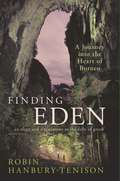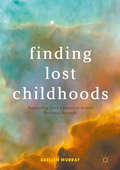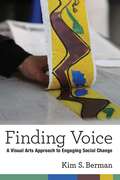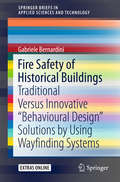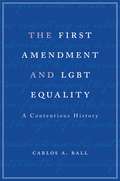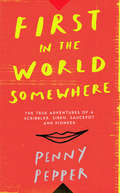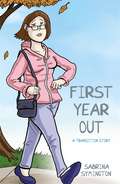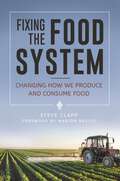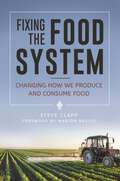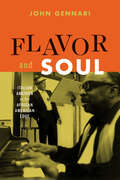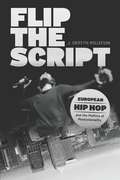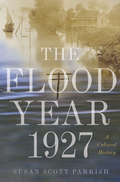- Table View
- List View
Finding Eden: A Journey into the Heart of Borneo
by Robin Hanbury-TenisonFifty years ago the interior of Borneo was a pristine, virgin rainforest inhabited by uncontacted indigenous tribes and naïve, virtually tame, wildlife. It was into this 'Garden of Eden' that Robin Hanbury Tenison led one of the largest ever Royal Geographical Society expeditions, an extraordinary undertaking which triggered the global rainforest movement and illuminated, for the first time, how vital rainforests are to our planet. For 15 months, Hanbury Tenison and a team of some of the greatest scientists in the world immersed themselves in a place and a way of life that is on the cusp of extinction. Much of what was once a wildlife paradise is now a monocultural desert, devastated by logging and the forced settlement of nomadic tribes, where traditional ways of life and unimaginably rich and diverse species are slowly being driven to extinction. This is a story for our time, one that reminds us of the fragility of our planet and of the urgent need to preserve the last untamed places of the world.
Finding Lost Childhoods: Supporting Care-Leavers to Access Personal Records
by Suellen MurrayThis book explores care-leavers’ access to their personal records. People who grew up in care in previous decades may know little about their family nor understand why they were placed in care nor how decisions were made about their lives. Personal records can be a source of this information. Murray posits that it is crucial that those releasing these records understand their significance. Taking a person-centred approach, the book is based on the moving life history accounts of people who have sought their records. Finding Lost Childhoods highlights the importance of records to their identity formation, recounts what they discovered about themselves and their family, and discusses the consequences of finding this information. With a focus on policy and practice implications, the book will be of particular interest to those engaged in the work of releasing records, as well as care-leavers themselves, professional bodies, and students and scholars with an interest in social work, policy studies, welfare studies and youth work.
Finding Lost Childhoods: Supporting Care-Leavers to Access Personal Records
by Suellen MurrayThis book explores care-leavers’ access to their personal records. People who grew up in care in previous decades may know little about their family nor understand why they were placed in care nor how decisions were made about their lives. Personal records can be a source of this information. Murray posits that it is crucial that those releasing these records understand their significance. Taking a person-centred approach, the book is based on the moving life history accounts of people who have sought their records. Finding Lost Childhoods highlights the importance of records to their identity formation, recounts what they discovered about themselves and their family, and discusses the consequences of finding this information. With a focus on policy and practice implications, the book will be of particular interest to those engaged in the work of releasing records, as well as care-leavers themselves, professional bodies, and students and scholars with an interest in social work, policy studies, welfare studies and youth work.
Finding Voice: A Visual Arts Approach to Engaging Social Change (The New Public Scholarship)
by Kim S BermanIn Finding Voice, Kim Berman demonstrates how she was able to use visual arts training in disenfranchised communities as a tool for political and social transformation in South Africa. Using her own fieldwork as a case study, Berman shows how hands-on work in the arts with learners of all ages and backgrounds can contribute to economic stability by developing new skills, as well as enhancing public health and gender justice within communities. Berman’s work, and the community artwork her book documents, present the visual arts as a crucial channel for citizens to find their individual voices and to become agents for change in the arenas of human rights and democracy.
Fire Safety of Historical Buildings: Traditional Versus Innovative “Behavioural Design” Solutions by Using Wayfinding Systems (SpringerBriefs in Applied Sciences and Technology)
by Gabriele BernardiniThis book applies a behavioral point of view to individuals’ fire safety in historic buildings. It outlines theoretical and operative issues, based on recent studies and international guidelines.Firstly, critical issues for Building Heritage fire safety are widely discussed, by including the modelling of human factor and man-environment-fire interference in these architectural spaces. A significant part of the book includes a discussion on emergency modeling and simulation. A source code for representing the fire evacuation process (including man-evacuation facilities interactions) is offered to the reader.Methods for effectiveness assessment of risk-reducing solutions are provided and tested in a case-study. Being a structured approach to occupants-related problems during a fire in heritage buildings, it offers an innovative methodology and practical examples that researchers and designers can use as a guide when proposing and testing solutions. Evaluation indexes for effectiveness assessment (also useful for future guidelines or handbooks) are included. Readers are encouraged to understand these indexes within the proposed approach, so as to extend their applications and possibilities of how to introduce human behaviors-based solutions in other fields. Lastly, attention is focused on the proposal and evaluation of low-impact and not-invasive strategies, such as ones based on wayfinding elements. From this point of view, the pros and cons of wayfinding systems are discussed: these are important today, especially for fire-safety designers, because of the ongoing innovations in this field.
Fire Woman: The Extraordinary Story of Britain's First Female Firefighter
by Josephine ReynoldsThe inspiring true story of Josephine Reynolds, Britain's first full-time female firefighter.When Josephine Reynolds signed up with the Norfolk Fire Service in July 1982 at just seventeen years old, there was no such thing as a firefighter – only fire men. Set against the slate-grey backdrop of early 1980s Britain, Fire Woman is the story of how a young woman brought up in rural Wales coped in the testosterone-fuelled world of the fire brigade, where even today 96 per cent of all staff are male. In a life packed with incident – where lethal forest fires, escaped zoo animals and unexploded bombs formed a background to the everyday toll of death and disaster – Josephine experienced both triumph and heartbreaking personal tragedy. Fire Woman also provides a unique insight into the camaraderie that comes with risking your life on a daily basis and stands as the inspiring true story of an extraordinary young woman who took on a man’s world and won, becoming Britain's first full-time firefighter.
The First Amendment and LGBT Equality: A Contentious History
by Carlos A. BallCarlos A. Ball argues that as progressives fight the First Amendment claims of religious conservatives and other LGBT opponents, they should take care not to forget the crucial role the First Amendment played in the early decades of the movement, and not to erode the safeguards of liberty that allowed LGBT rights to exist in the first place.
The First Amendment and LGBT Equality: A Contentious History
by Carlos A. BallCarlos A. Ball argues that as progressives fight the First Amendment claims of religious conservatives and other LGBT opponents, they should take care not to forget the crucial role the First Amendment played in the early decades of the movement, and not to erode the safeguards of liberty that allowed LGBT rights to exist in the first place.
First in the World Somewhere: The True Adventures of a Scribbler, Siren, Saucepot and Pioneer
by Penny PepperPenny Pepper has led an extraordinary life. She is a writer. Poet. Punk. Pioneer. Activist. And she also happens to be disabled. In her absorbing memoir, which spans the mid-1980s up until the millennium, Penny paints a picture of life, love, sex, music, success, failure and misadventures in the UK punk scene of the late 20th century. Craving freedom from the poor Chiltern Hill council estate where she grew up, Penny dreams of moving to London, of writing, of finding her way in the North London music scene. She doesn’t have what others take for granted; she is disabled. And she sets out with just her raw, burgeoning talent to fight the social demons of indifference, discrimination and out-right bigotry… all while wearing micro-mini leather bondage skirts, fishnets and hair extensions.There are parties; there’s sex; there’s music. She exchanges letters with Morrissey. Ken Livingstone helps her find a wheelchair-accessible flat. Her demo tape is reviewed in the NME and played on the radio. Her 90s album Spiral Sky is No. 1 in Greece for a week. And there is opportunity – opportunity to join the radical beginnings of the disability rights movement. First in the World Somewhere tells of her endless adventures. Through the years, there’s an overload of adventure, despair and joy. Often faced with prejudice, she fails, she suffers, she survives and she even sometimes succeeds. Penny does not deny her disability; rather she keeps it at the forefront of everything she stands for, and she tells her story with blood, heart and an undeniable wit.
First Year Out: A Transition Story (PDF)
by Sabrina SymingtonFrom laser hair removal and coming out to her parents, through to dating, voice training and gender reassignment surgery, this intimate and witty graphic novel follows the character of Lily as she transitions to living as her true, female self. Providing support and guidance on a range of issues such as hormones, medical procedures and relationships, the story traces the everyday thoughts, emotions and struggles many trans and non-binary people face and seeks to empower those who are starting to question their gender as well as promoting wider discussion about the complexities of gender and identity. Based on the author's own experiences as a trans woman, this honest and powerful work is a testament to being who you are and a celebration of gender diversity.
Fixing the Food System: Changing How We Produce and Consume Food
by Steve ClappAmerica's broken food system has provoked an outcry from consumer advocates seeking to align food policies with public health objectives. This book examines both sides of the conflict for solutions.Many believe that America's food system is in dire need of reform, with concerns ranging from the obesity epidemic to exploitative labor practices and negative environmental impact. This eye-opening book answers provocative questions about what changes are needed, who is advocating the changes, what parties are opposing these changes (and why), and what a new food system would look like. Organized into three sections, the work identifies the problems with the current system, reviews the changing landscape of food policy, and suggests workable solutions for progress.Washington insider Steve Clapp takes a comprehensive look at the struggle over the future of food. He examines the vision for a reformed national food policy that includes calculating the true cost of food, providing universal access to healthful food, adopting farm policies supporting public health and environmental objectives, improving food safety, paying fair wages to food employees, treating food animals with compassion, and reducing the food system's carbon footprint. The book explores the ways in which these issues can be resolved, drawing upon lessons learned from the early food advocates of the 1960s and 1970s.
Fixing the Food System: Changing How We Produce and Consume Food
by Steve ClappAmerica's broken food system has provoked an outcry from consumer advocates seeking to align food policies with public health objectives. This book examines both sides of the conflict for solutions.Many believe that America's food system is in dire need of reform, with concerns ranging from the obesity epidemic to exploitative labor practices and negative environmental impact. This eye-opening book answers provocative questions about what changes are needed, who is advocating the changes, what parties are opposing these changes (and why), and what a new food system would look like. Organized into three sections, the work identifies the problems with the current system, reviews the changing landscape of food policy, and suggests workable solutions for progress.Washington insider Steve Clapp takes a comprehensive look at the struggle over the future of food. He examines the vision for a reformed national food policy that includes calculating the true cost of food, providing universal access to healthful food, adopting farm policies supporting public health and environmental objectives, improving food safety, paying fair wages to food employees, treating food animals with compassion, and reducing the food system's carbon footprint. The book explores the ways in which these issues can be resolved, drawing upon lessons learned from the early food advocates of the 1960s and 1970s.
Flavor and Soul: Italian America at Its African American Edge
by John GennariIn the United States, African American and Italian cultures have been intertwined for more than a hundred years. From as early as nineteenth-century African American opera star Thomas Bowers—“The Colored Mario”—all the way to hip-hop entrepreneur Puff Daddy dubbing himself “the Black Sinatra,” the affinity between black and Italian cultures runs deep and wide. Once you start looking, you’ll find these connections everywhere. Sinatra croons bel canto over the limousine swing of the Count Basie band. Snoop Dogg deftly tosses off the line “I’m Lucky Luciano ’bout to sing soprano.” Like the Brooklyn pizzeria and candy store in Spike Lee’s Do the Right Thing and Jungle Fever, or the basketball sidelines where Italian American coaches Rick Pitino and John Calipari mix it up with their African American players, black/Italian connections are a thing to behold—and to investigate. In Flavor and Soul, John Gennari spotlights this affinity, calling it “the edge”—now smooth, sometimes serrated—between Italian American and African American culture. He argues that the edge is a space of mutual emulation and suspicion, a joyous cultural meeting sometimes darkened by violent collision. Through studies of music and sound, film and media, sports and foodways, Gennari shows how an Afro-Italian sensibility has nourished and vitalized American culture writ large, even as Italian Americans and African Americans have fought each other for urban space, recognition of overlapping histories of suffering and exclusion, and political and personal rispetto. Thus, Flavor and Soul is a cultural contact zone—a piazza where people express deep feelings of joy and pleasure, wariness and distrust, amity and enmity. And it is only at such cultural edges, Gennari argues, that America can come to truly understand its racial and ethnic dynamics.
Flavor and Soul: Italian America at Its African American Edge
by John GennariIn the United States, African American and Italian cultures have been intertwined for more than a hundred years. From as early as nineteenth-century African American opera star Thomas Bowers—“The Colored Mario”—all the way to hip-hop entrepreneur Puff Daddy dubbing himself “the Black Sinatra,” the affinity between black and Italian cultures runs deep and wide. Once you start looking, you’ll find these connections everywhere. Sinatra croons bel canto over the limousine swing of the Count Basie band. Snoop Dogg deftly tosses off the line “I’m Lucky Luciano ’bout to sing soprano.” Like the Brooklyn pizzeria and candy store in Spike Lee’s Do the Right Thing and Jungle Fever, or the basketball sidelines where Italian American coaches Rick Pitino and John Calipari mix it up with their African American players, black/Italian connections are a thing to behold—and to investigate. In Flavor and Soul, John Gennari spotlights this affinity, calling it “the edge”—now smooth, sometimes serrated—between Italian American and African American culture. He argues that the edge is a space of mutual emulation and suspicion, a joyous cultural meeting sometimes darkened by violent collision. Through studies of music and sound, film and media, sports and foodways, Gennari shows how an Afro-Italian sensibility has nourished and vitalized American culture writ large, even as Italian Americans and African Americans have fought each other for urban space, recognition of overlapping histories of suffering and exclusion, and political and personal rispetto. Thus, Flavor and Soul is a cultural contact zone—a piazza where people express deep feelings of joy and pleasure, wariness and distrust, amity and enmity. And it is only at such cultural edges, Gennari argues, that America can come to truly understand its racial and ethnic dynamics.
Flavor and Soul: Italian America at Its African American Edge
by John GennariIn the United States, African American and Italian cultures have been intertwined for more than a hundred years. From as early as nineteenth-century African American opera star Thomas Bowers—“The Colored Mario”—all the way to hip-hop entrepreneur Puff Daddy dubbing himself “the Black Sinatra,” the affinity between black and Italian cultures runs deep and wide. Once you start looking, you’ll find these connections everywhere. Sinatra croons bel canto over the limousine swing of the Count Basie band. Snoop Dogg deftly tosses off the line “I’m Lucky Luciano ’bout to sing soprano.” Like the Brooklyn pizzeria and candy store in Spike Lee’s Do the Right Thing and Jungle Fever, or the basketball sidelines where Italian American coaches Rick Pitino and John Calipari mix it up with their African American players, black/Italian connections are a thing to behold—and to investigate. In Flavor and Soul, John Gennari spotlights this affinity, calling it “the edge”—now smooth, sometimes serrated—between Italian American and African American culture. He argues that the edge is a space of mutual emulation and suspicion, a joyous cultural meeting sometimes darkened by violent collision. Through studies of music and sound, film and media, sports and foodways, Gennari shows how an Afro-Italian sensibility has nourished and vitalized American culture writ large, even as Italian Americans and African Americans have fought each other for urban space, recognition of overlapping histories of suffering and exclusion, and political and personal rispetto. Thus, Flavor and Soul is a cultural contact zone—a piazza where people express deep feelings of joy and pleasure, wariness and distrust, amity and enmity. And it is only at such cultural edges, Gennari argues, that America can come to truly understand its racial and ethnic dynamics.
Flavor and Soul: Italian America at Its African American Edge
by John GennariIn the United States, African American and Italian cultures have been intertwined for more than a hundred years. From as early as nineteenth-century African American opera star Thomas Bowers—“The Colored Mario”—all the way to hip-hop entrepreneur Puff Daddy dubbing himself “the Black Sinatra,” the affinity between black and Italian cultures runs deep and wide. Once you start looking, you’ll find these connections everywhere. Sinatra croons bel canto over the limousine swing of the Count Basie band. Snoop Dogg deftly tosses off the line “I’m Lucky Luciano ’bout to sing soprano.” Like the Brooklyn pizzeria and candy store in Spike Lee’s Do the Right Thing and Jungle Fever, or the basketball sidelines where Italian American coaches Rick Pitino and John Calipari mix it up with their African American players, black/Italian connections are a thing to behold—and to investigate. In Flavor and Soul, John Gennari spotlights this affinity, calling it “the edge”—now smooth, sometimes serrated—between Italian American and African American culture. He argues that the edge is a space of mutual emulation and suspicion, a joyous cultural meeting sometimes darkened by violent collision. Through studies of music and sound, film and media, sports and foodways, Gennari shows how an Afro-Italian sensibility has nourished and vitalized American culture writ large, even as Italian Americans and African Americans have fought each other for urban space, recognition of overlapping histories of suffering and exclusion, and political and personal rispetto. Thus, Flavor and Soul is a cultural contact zone—a piazza where people express deep feelings of joy and pleasure, wariness and distrust, amity and enmity. And it is only at such cultural edges, Gennari argues, that America can come to truly understand its racial and ethnic dynamics.
Flip the Script: European Hip Hop and the Politics of Postcoloniality (Chicago Studies in Ethnomusicology)
by J. Griffith RollefsonHip hop has long been a vehicle for protest in the United States, used by its primarily African American creators to address issues of prejudice, repression, and exclusion. But the music is now a worldwide phenomenon, and outside the United States it has been taken up by those facing similar struggles. Flip the Script offers a close look at the role of hip hop in Europe, where it has become a politically powerful and commercially successful form of expression for the children and grandchildren of immigrants from former colonies. Through analysis of recorded music and other media, as well as interviews and fieldwork with hip hop communities, J. Griffith Rollefson shows how this music created by black Americans is deployed by Senegalese Parisians, Turkish Berliners, and South Asian Londoners to both differentiate themselves from and relate themselves to the dominant culture. By listening closely to the ways these postcolonial citizens in Europe express their solidarity with African Americans through music, Rollefson shows, we can literally hear the hybrid realities of a global double consciousness.
Flip the Script: European Hip Hop and the Politics of Postcoloniality (Chicago Studies in Ethnomusicology)
by J. Griffith RollefsonHip hop has long been a vehicle for protest in the United States, used by its primarily African American creators to address issues of prejudice, repression, and exclusion. But the music is now a worldwide phenomenon, and outside the United States it has been taken up by those facing similar struggles. Flip the Script offers a close look at the role of hip hop in Europe, where it has become a politically powerful and commercially successful form of expression for the children and grandchildren of immigrants from former colonies. Through analysis of recorded music and other media, as well as interviews and fieldwork with hip hop communities, J. Griffith Rollefson shows how this music created by black Americans is deployed by Senegalese Parisians, Turkish Berliners, and South Asian Londoners to both differentiate themselves from and relate themselves to the dominant culture. By listening closely to the ways these postcolonial citizens in Europe express their solidarity with African Americans through music, Rollefson shows, we can literally hear the hybrid realities of a global double consciousness.
Flip the Script: European Hip Hop and the Politics of Postcoloniality (Chicago Studies in Ethnomusicology)
by J. Griffith RollefsonHip hop has long been a vehicle for protest in the United States, used by its primarily African American creators to address issues of prejudice, repression, and exclusion. But the music is now a worldwide phenomenon, and outside the United States it has been taken up by those facing similar struggles. Flip the Script offers a close look at the role of hip hop in Europe, where it has become a politically powerful and commercially successful form of expression for the children and grandchildren of immigrants from former colonies. Through analysis of recorded music and other media, as well as interviews and fieldwork with hip hop communities, J. Griffith Rollefson shows how this music created by black Americans is deployed by Senegalese Parisians, Turkish Berliners, and South Asian Londoners to both differentiate themselves from and relate themselves to the dominant culture. By listening closely to the ways these postcolonial citizens in Europe express their solidarity with African Americans through music, Rollefson shows, we can literally hear the hybrid realities of a global double consciousness.
Flip the Script: European Hip Hop and the Politics of Postcoloniality (Chicago Studies in Ethnomusicology)
by J. Griffith RollefsonHip hop has long been a vehicle for protest in the United States, used by its primarily African American creators to address issues of prejudice, repression, and exclusion. But the music is now a worldwide phenomenon, and outside the United States it has been taken up by those facing similar struggles. Flip the Script offers a close look at the role of hip hop in Europe, where it has become a politically powerful and commercially successful form of expression for the children and grandchildren of immigrants from former colonies. Through analysis of recorded music and other media, as well as interviews and fieldwork with hip hop communities, J. Griffith Rollefson shows how this music created by black Americans is deployed by Senegalese Parisians, Turkish Berliners, and South Asian Londoners to both differentiate themselves from and relate themselves to the dominant culture. By listening closely to the ways these postcolonial citizens in Europe express their solidarity with African Americans through music, Rollefson shows, we can literally hear the hybrid realities of a global double consciousness.
Flip the Script: European Hip Hop and the Politics of Postcoloniality (Chicago Studies in Ethnomusicology)
by J. Griffith RollefsonHip hop has long been a vehicle for protest in the United States, used by its primarily African American creators to address issues of prejudice, repression, and exclusion. But the music is now a worldwide phenomenon, and outside the United States it has been taken up by those facing similar struggles. Flip the Script offers a close look at the role of hip hop in Europe, where it has become a politically powerful and commercially successful form of expression for the children and grandchildren of immigrants from former colonies. Through analysis of recorded music and other media, as well as interviews and fieldwork with hip hop communities, J. Griffith Rollefson shows how this music created by black Americans is deployed by Senegalese Parisians, Turkish Berliners, and South Asian Londoners to both differentiate themselves from and relate themselves to the dominant culture. By listening closely to the ways these postcolonial citizens in Europe express their solidarity with African Americans through music, Rollefson shows, we can literally hear the hybrid realities of a global double consciousness.
Flip the Script: European Hip Hop and the Politics of Postcoloniality (Chicago Studies in Ethnomusicology)
by J. Griffith RollefsonHip hop has long been a vehicle for protest in the United States, used by its primarily African American creators to address issues of prejudice, repression, and exclusion. But the music is now a worldwide phenomenon, and outside the United States it has been taken up by those facing similar struggles. Flip the Script offers a close look at the role of hip hop in Europe, where it has become a politically powerful and commercially successful form of expression for the children and grandchildren of immigrants from former colonies. Through analysis of recorded music and other media, as well as interviews and fieldwork with hip hop communities, J. Griffith Rollefson shows how this music created by black Americans is deployed by Senegalese Parisians, Turkish Berliners, and South Asian Londoners to both differentiate themselves from and relate themselves to the dominant culture. By listening closely to the ways these postcolonial citizens in Europe express their solidarity with African Americans through music, Rollefson shows, we can literally hear the hybrid realities of a global double consciousness.
The Flood Year 1927: A Cultural History
by Susan Scott ParrishThe Great Mississippi Flood of 1927, which covered nearly thirty thousand square miles across seven states, was the most destructive river flood in U.S. history. Due to the speed of new media and the slow progress of the flood, this was the first environmental disaster to be experienced on a mass scale. As it moved from north to south down an environmentally and technologically altered valley, inundating plantations and displacing more than half a million people, the flood provoked an intense and lasting cultural response. The Flood Year 1927 draws from newspapers, radio broadcasts, political cartoons, vaudeville, blues songs, poetry, and fiction to show how this event took on public meanings.Americans at first seemed united in what Herbert Hoover called a "great relief machine," but deep rifts soon arose. Southerners, pointing to faulty federal levee design, decried the attack of Yankee water. The condition of African American evacuees in “concentration camps” prompted pundits like W.E.B. Du Bois and Ida B. Wells to warn of the return of slavery to Dixie. And environmentalists like Gifford Pinchot called the flood “the most colossal blunder in civilized history.” Susan Scott Parrish examines how these and other key figures—from entertainers Will Rogers, Miller & Lyles, and Bessie Smith to authors Sterling Brown, William Faulkner, and Richard Wright—shaped public awareness and collective memory of the event.The crises of this period that usually dominate historical accounts are war and financial collapse, but The Flood Year 1927 enables us to assess how mediated environmental disasters became central to modern consciousness.
The Flood Year 1927: A Cultural History
by Susan Scott ParrishThe Great Mississippi Flood of 1927, which covered nearly thirty thousand square miles across seven states, was the most destructive river flood in U.S. history. Due to the speed of new media and the slow progress of the flood, this was the first environmental disaster to be experienced on a mass scale. As it moved from north to south down an environmentally and technologically altered valley, inundating plantations and displacing more than half a million people, the flood provoked an intense and lasting cultural response. The Flood Year 1927 draws from newspapers, radio broadcasts, political cartoons, vaudeville, blues songs, poetry, and fiction to show how this event took on public meanings.Americans at first seemed united in what Herbert Hoover called a "great relief machine," but deep rifts soon arose. Southerners, pointing to faulty federal levee design, decried the attack of Yankee water. The condition of African American evacuees in “concentration camps” prompted pundits like W.E.B. Du Bois and Ida B. Wells to warn of the return of slavery to Dixie. And environmentalists like Gifford Pinchot called the flood “the most colossal blunder in civilized history.” Susan Scott Parrish examines how these and other key figures—from entertainers Will Rogers, Miller & Lyles, and Bessie Smith to authors Sterling Brown, William Faulkner, and Richard Wright—shaped public awareness and collective memory of the event.The crises of this period that usually dominate historical accounts are war and financial collapse, but The Flood Year 1927 enables us to assess how mediated environmental disasters became central to modern consciousness.
Flucht, Migration und die neue europäische Sicherheitsarchitektur: Herausforderungen für die EU-Kriminalpolitik
by Robin HofmannRobin Hofmann zeigt im vorliegenden Buch, wie in der Flüchtlingskrise die neue europäische Sicherheitsarchitektur zunehmend an ihre Grenzen stößt. Der Autor schlägt einen Bogen von der historischen Entwicklung einer gemeinsamen europäischen Kriminalitätsbekämpfung über das bestehende Sicherheitsagentursystem bis hin zu dem heutigen europäischen Grenz- und Asylsystem. Zentrales Argument ist dabei, dass die zunehmende Versicherheitlichung politischer Probleme nicht gleichbedeutend mit deren Lösung ist.
